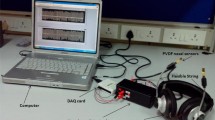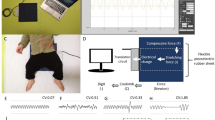Abstract
Design and development of a piezoelectric polyvinylidene fluoride (PVDF) thin film based nasal sensor to monitor human respiration pattern (RP) from each nostril simultaneously is presented in this paper. Thin film based PVDF nasal sensor is designed in a cantilever beam configuration. Two cantilevers are mounted on a spectacle frame in such a way that the air flow from each nostril impinges on this sensor causing bending of the cantilever beams. Voltage signal produced due to air flow induced dynamic piezoelectric effect produce a respective RP. A group of 23 healthy awake human subjects are studied. The RP in terms of respiratory rate (RR) and Respiratory air-flow changes/alterations obtained from the developed PVDF nasal sensor are compared with RP obtained from respiratory inductance plethysmograph (RIP) device. The mean RR of the developed nasal sensor (19.65 ± 4.1) and the RIP (19.57 ± 4.1) are found to be almost same (difference not significant, p > 0.05) with the correlation coefficient 0.96, p < 0.0001. It was observed that any change/alterations in the pattern of RIP is followed by same amount of change/alterations in the pattern of PVDF nasal sensor with k = 0.815 indicating strong agreement between the PVDF nasal sensor and RIP respiratory air-flow pattern. The developed sensor is simple in design, non-invasive, patient friendly and hence shows promising routine clinical usage. The preliminary result shows that this new method can have various applications in respiratory monitoring and diagnosis.








Similar content being viewed by others
References
Lec MR. Piezoelectric biosensors: recent advances and applications. IEEE international frequency control symposium and PDA exhibition; 2001.
Ikeda K, Watanabe A, Saito M. A vital sign sensor for elderly people at home, Biotelemetry, vol 11; 1991.
Folke M, Cernerud L, Ekstrom M, Hok B. Critical review of non-invasive respiratory monitoring in medical care. Med Biol Eng Comput. 2003;41:377–83.
Cretikos MA. Respiratory rate: the neglected vital sign’. Med J Aust. 2008;11:657–9.
A. Timothy ueen: ‘ear, nose, throat and allergy–nasal obstruction’, 2003. http://www.vaentallery.com/nasal_obstruction.html.
Berg S, Haight JS, Yap V, Hoffstein V, Cole P. Comparison of direct and indirect Measurements of respiratory airflow: implications for hypopneas. Sleep. 1997;20:60–4.
Krieger B, Feinerman D, Zaron A. Continuous non-invasive monitoring of respiratory rate in critically ill patients. Chest. 1986;90:632–4.
Simoes EA, Rourte R, Berman S. Respiratory rate: measurement of variability over time and accurately at different counting periods. Arch Dis Child. 1991;66:1199–203.
Freundlich JJ, Erickson JC. Electrical impedance pneumography for simple non-restrictive continuous monitoring of respiratory rate, rhythm and tidal volume for surgical patients. Chest. 1974;65:181–4.
Sage J, Gough W. A simple inexpensive device for monitoring patient respiration. Med Biol Eng Comput. 1998;36:231–2.
Pettersson H, Stenow EN, Cai H. Optical aspects of a fibre-optic sensor for respiratory rate monitoring. Med Biol Eng Comput. 1996;34:448–52.
De Meersman RE, Zion AS, Teitelbaum S. Deriving respiration from pulse wave: a new signal-processing technique. Am J Physiol. 1996;270:1672–5.
Linko K, Paloheimo M. Monitoring of the inspired and end-tidal oxygen, carbon dioxid, and nitrous oxide concentrations: clinical applications during anesthesia and recovery. J Clin Monit Comput. 1989;5:149–56.
Dodds D, Purdy J, Moulton D. The PEP transducer: a new way of measuring Respiratory rate in the non-intubated patient. J Accid Med. 1999;16:26–8.
Tobin MJ. Respiratory monitoring in the intensive care unit. Am Rev Respir Dis. 1988;138:1625–42.
Cohn MA, Rao ASV, Broudy M, Birch S, Watson H, Atkins N, Davis B, Stott FD, Sackner MA. The respiratory inductive plethysmograph: a new noninvasive monitor of respiration. Bull Europ Physiopathol Respir. 1982;18:643–58.
Kawai H. The piezoelectric of polyvinylidene fluoride. J Appl Phys. 1969;8:73–7.
Huang YP, Young MS, Huang KN. Respiratory rate monitoring gauze mask system based on a pyroelectric transducer. Proceedings of IEEE; 2008. pp. 1648–1649.
Kulkarni V, Cyna A, Hutenison JM, Tunstall ME, Mallard J. AURA: a new respiratory monitor. Biomed Sci Instrum. 1990;26:111–20.
Siivola J. New non-invasive piezoelectric transducer for recording of respiration, heart rate and body movements. Med Bio Eng Comp. 1989;27:423–4.
Niizeki K, Nishidate I, Uchida K, Kuwahara M. Unconstrained cardiorespiratory and body movement monitoring system for home care. Med Biol Eng Comput. 2005;43:716–24.
Kärki S, Lekkala J. Film-type transducer materials PVDF and EMFi in the measurement of heart and respiration rate. Proceedings of International IEEE EMBS Conference; 2008. pp. 530–533.
Choi S, Jiang Z. A novel wearable sensor device with conductive fabric and PVDF film for monitoring cardiorespiratory signals. Sens Actuators A. 2006;128:317–26.
Bland JM, Altman DG. Statistical methods for assessing agreement between two methods of clinical measurements. Lancet. 1986;8:307–10.
Altman DG. Practical statistics for medical research. New York: Chapman Hall; 1999. p. 403–7.
Ono Y, Liu Q, Kobayashi M, Je CK, Blouin A. A Piezoelectric membrane sensor for biomedical monitoring. IEEE Ultrasonics Symposium; 2006.
Farre R, Montserrat JM, Navajas D. Noninvasive monitoring of respiratory mechanics during sleep. J Eur Respir. 2004;24:1052–60.
Cohen KR, Ladd WM, Beams DM, Sheers WS, Radwin RG, Tompkins WJ, Webster JG. Comparison of impedance and inductance ventilation sensors on adults during breathing, motion, and simulated airway obstruction. IEEE Trans Biorned Eng. 1997;44:555–66.
Watson HL, Poole DA, Sackner MA. Accuracy of respiratory inductive plethysmographic cross-sectional areas. J Appl Physiol. 1988;65:306–8.
Sackner MA, Watson H, Belsito AS, Feinerman D, Suarez M, Gonzalez G, Bizousky F, Krieger B. Calibration of respiratory inductive plethysmograph during natural breathing. J Appl Physiol. 1989;66:410–20.
Herman IP. Biological and medical physics, biomedical engineering—physics of human body. 2nd ed. New York: Springer; 2008.
Grant HD, Murry RD, Bergeron JD. Emergency care. 4th ed. USA: Prentice-hall; 1986.
Berry RB, Koch GL, Trautz S, Wagner MH. Comparison of respiratory event detection by polyvinylidene fluoride and a Pneumotachograph in sleep apnea patients. Chest. 2005;128:1331–8.
Cole P, Ayiomanimitis A, Ohki M. Anterior and posterior rhinometry. Rhinology. 1989;27:257–62.
Acknowledgments
Authors thank Dr. Nirmala KS, EEG and Sleep lab, M S Ramaiah Medical Collage and Hospital, Bangalore, India, for her help and advice during data collection. Authors also thank Prof. N S Murthy and Ms. Radhika, Department of Biostatistics, M S Ramaiah Medical College and Hospital, Bangalore, India for their valuable inputs and kind help.
Author information
Authors and Affiliations
Corresponding author
Rights and permissions
About this article
Cite this article
Roopa Manjunatha, G., Rajanna, K., Mahapatra, D.R. et al. Polyvinylidene fluoride film based nasal sensor to monitor human respiration pattern: An initial clinical study. J Clin Monit Comput 27, 647–657 (2013). https://doi.org/10.1007/s10877-013-9486-x
Received:
Accepted:
Published:
Issue Date:
DOI: https://doi.org/10.1007/s10877-013-9486-x




